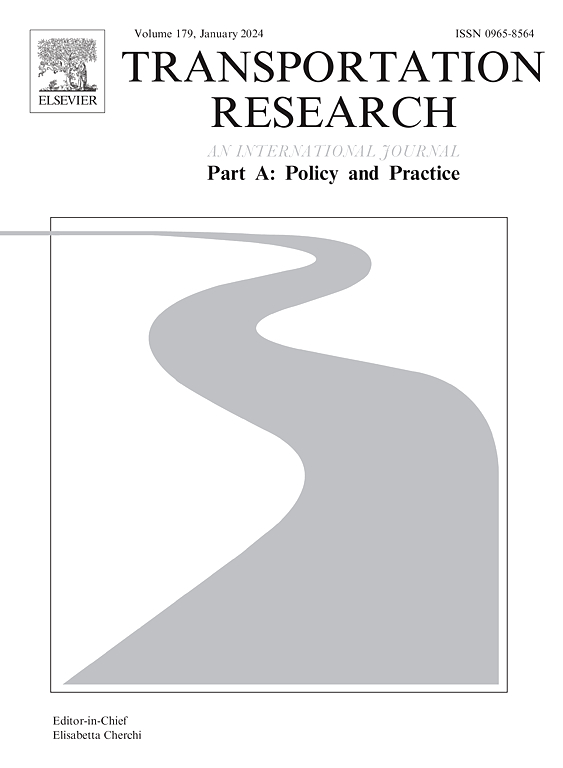对绿色汽车和化石燃料汽车的需求
IF 6.3
1区 工程技术
Q1 ECONOMICS
Transportation Research Part A-Policy and Practice
Pub Date : 2024-10-21
DOI:10.1016/j.tra.2024.104284
引用次数: 0
摘要
要实现净零排放的政策目标,就必须从传统汽车 (CV) 向更环保的替代燃料汽车 (AFV) 过渡。本文通过考察车辆属性、价格以及品牌、原产国、汽车细分市场和车辆设备等其他因素,研究了英国大型汽车市场对 AFV 和 CV 需求的影响因素。利用覆盖 2008-2019 年的广泛而独特的数据集,我们计算了 CV 和 AFV 的自有价格、交叉价格和需求弹性。应用随机系数离散选择需求模型,并控制消费者异质性、未观察到的产品特征和价格内生性,我们发现需求的主要驱动因素是价格、燃料消耗量和车辆尺寸,而 CV 和 AFV 的需求敏感性相似。在替代品的质量和可用性条件下,无级变速器和无级自动变速器的价格每增加 1000 英镑,需求量就会下降 3%-5%。这表明,英国消费者并不愿意为无燃料汽车支付溢价,这说明无燃料汽车的 "绿色 "价值并不高。我们估计,如果为购买自动驾驶汽车提供 1000 英镑的补贴,将有 4% 的消费者转而购买更环保的汽车。虽然商用车和农用车表现出相似的价格弹性,但车辆尺寸对农用车需求的影响要高出约 40%,因为农用车购买者更看重小尺寸车辆。我们的研究结果表明,如果没有经济激励措施,AFV 的使用率可能会保持在较低水平,因为对于大多数消费者来说,较高的成本和较低的便利性超过了对环保的考虑。本文章由计算机程序翻译,如有差异,请以英文原文为准。
Demand for green and fossil fuel automobiles
Net-zero policy targets will require a transition from conventional vehicles (CVs) to greener alternative fuel vehicles (AFVs). This paper examines what influences the demand for AFVs and CVs in the UK’s large automobile market, looking at vehicle attributes, prices, and other factors, such as brands, country of origin, car segments, and vehicle equipment. Using an extensive, unique dataset covering the period 2008–2019, we compute own-price, cross-price, and demand elasticities for CVs and AFVs. Applying a random-coefficient discrete-choice model of demand, and controlling for consumer heterogeneity, unobserved product characteristics, and price endogeneity, we find that the key drivers of demand are prices, fuel consumption, and vehicle size, with similar demand sensitivity between CVs and AFVs. Demand falls by 3%–5% for a ₤1,000 increase in price for both CVs and AFVs, conditional on the quality and availability of substitutes. This indicates that UK consumers are not willing to pay a price premium for AFVs, suggesting little value placed on the “greenness” of AFVs. We estimate that a ₤1,000 subsidy to AFV purchases would lead to 4% of consumers switching to the greener vehicles. While CVs and AFVs exhibit similar price elasticities, vehicle size affects AFV demand by about 40% more, as their purchasers value smaller sized vehicles. Our results indicate that without financial incentives, the uptake of AFVs may remain low, as the higher cost and lower convenience outweighs the environmental considerations for the majority of consumers.
求助全文
通过发布文献求助,成功后即可免费获取论文全文。
去求助
来源期刊
CiteScore
13.20
自引率
7.80%
发文量
257
审稿时长
9.8 months
期刊介绍:
Transportation Research: Part A contains papers of general interest in all passenger and freight transportation modes: policy analysis, formulation and evaluation; planning; interaction with the political, socioeconomic and physical environment; design, management and evaluation of transportation systems. Topics are approached from any discipline or perspective: economics, engineering, sociology, psychology, etc. Case studies, survey and expository papers are included, as are articles which contribute to unification of the field, or to an understanding of the comparative aspects of different systems. Papers which assess the scope for technological innovation within a social or political framework are also published. The journal is international, and places equal emphasis on the problems of industrialized and non-industrialized regions.
Part A''s aims and scope are complementary to Transportation Research Part B: Methodological, Part C: Emerging Technologies and Part D: Transport and Environment. Part E: Logistics and Transportation Review. Part F: Traffic Psychology and Behaviour. The complete set forms the most cohesive and comprehensive reference of current research in transportation science.

 求助内容:
求助内容: 应助结果提醒方式:
应助结果提醒方式:


